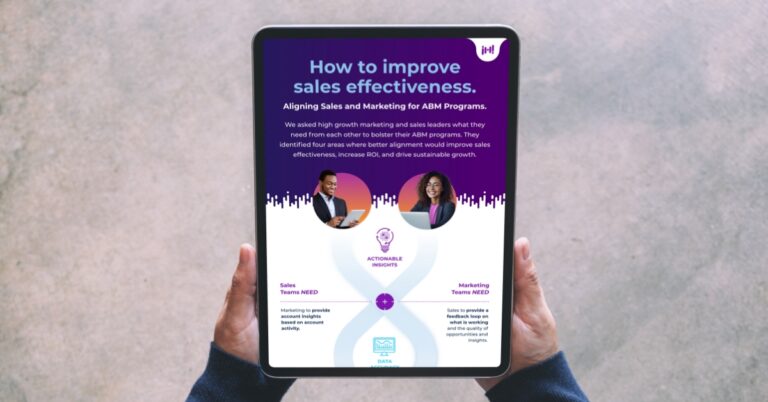In today’s crowded and competitive B2B landscape, personalized and targeted content strategies are essential to drive conversions.
These strategies are even more important when it comes to account based marketing (ABM), which has emerged as a fundamental approach to driving predictable growth.
Here’s how:
- ABM empowers companies to focus their resources on high-value accounts. This allows them to create content that directly addresses the unique needs, challenges, and pain points of those accounts, capturing their attention with more impact to drive engagement.
- ABM enables companies to target prospects across the entire buyer’s journey. This approach works best when companies create content for the evolving informational needs and interests of buyers at target accounts as they progress through the various stages of their buying process.
In fact, according to Iron Horse’s Investment Insights Report for 2024 Budget Planning, many high-growth B2B companies plan to invest in content technology, content intelligence tools, and/or content teams this year, demonstrating a belief in the power of relevant, personalized content.
But creating effective content for ABM can be particularly challenging. One common obstacle is a lack of content that is suitable for ABM. Many companies find themselves with a limited library of assets that aren’t tailored to specific accounts or the various stages of the buyer’s journey. Even if you have a decent amount of content, much of it may be generic or outdated, lacking the specificity and relevance needed for successful ABM.
However, these challenges can be overcome with the right approach and strategies. That’s why we’re highlighting best practices for ABM content creation, including tips from Iron Horse content strategists and ABM experts, to help you create high quality, targeted content that effectively engages your target accounts and drives tangible results for your ABM program.
So, let’s get started…
What makes great ABM content?
Before launching into specific steps you can take to develop effective content for ABM, let’s cover some fundamentals.
Focus on your audience.
When crafting ABM content, one of the most critical factors to consider is ensuring that your content is audience-centered rather than product-centered or company-centered.
Audience-centered content focuses on delivering value and relevance. Instead of focusing on the features and benefits of your products or services, audience-centered content aims to provide solutions, insights, and resources that directly address the concerns and objectives of buying group members at your target accounts.
Pro Tip: Maria Gianotti, Senior Director of Growth Marketing.
Think of your content as deposits before you ask for a withdrawal (the “hand-raiser”). Ask yourself: What does your audience need to know throughout the different stages of the buyer’s journey, and how do they prefer to consume content? Once you’ve defined what makes your customers’ buyer’s journey and content preferences, share content assets that are useful vs. solution-focused.
Personalization is key.
Personalization goes beyond simply inserting your recipient’s name into an email or addressing their company by name. It involves creating content for ABM that speaks directly to the individual roles, responsibilities, and pain points of the decision-makers and influencers within your target accounts. This could include addressing industry-specific challenges, providing insights related to their particular job functions, or offering solutions tailored to their specific goals and priorities.
For example, rather than relying on a generic whitepaper on a broad industry topic, provide a case study that showcases how a similar company overcame a specific challenge relevant to your prospect’s role or industry. Or, you might provide an interactive asset like a customized ROI calculator that demonstrates the potential value of your company’s solution based on your prospect’s unique circumstances.
Pro Tip: Amber Keller, Associate Content Director.
A lot of companies treat personalization like a monogram on a set of towels. It’s not. Successful personalization begins with thinking about the real people in your target audience and making content that will make their day—by speaking their language, appealing to their sensibilities, and showing them a way to do their jobs better.
Span the full buyer’s journey.
Having content assets that span the entire buyer’s journey allows you to support prospects at each step of their decision making process.
Today’s buyers want to be well-informed about your solution long before they engage in a sales conversation. By meeting your prospects where they are in their journey with the right content, you build trust, demonstrate value, and keep them engaged, moving seamlessly through the sales funnel.
For a successful ABM program, this typically requires that you have a mix of high- value, gated content that can be used for lead generation via content syndication, plus a diverse range of content pieces to nurture prospects throughout the journey.
Pro Tip: Jon Vann Sprecher, Senior Content Strategist.
Think about the ‘start state’ and ‘end state’ of the buyer for any given piece of content—as well as for a campaign as a whole.
What conditions are true before the buyer consumes a piece of content?
- Are they problem-aware?
- Do they need to be convinced that your solution will address their challenges?
- Are they seeking to validate your solution in terms of price, implementation, etc?
What is the desired end state, after they consume the content?
- Do you want them to believe your solution is the right fit for them?
- Do you want them to seek more info, via further reading or a demo?
- Do you want them to see your company as a legitimate thought leader in the space?
Determining these start/end states will help you guide the placement of existing content, develop new content, and structure your ABM campaign accordingly.
Create content formats your target audiences want.
Your ABM content should not only be personalized in terms of messaging but also tailored to suit the preferred content consumption habits of the individuals within your target accounts.
While some buying team members may prefer to consume long-form content such as white papers or case studies to gain in-depth insights, others may prefer shorter, more visual formats like infographics or videos that convey information quickly and succinctly. A variety of formats ensures that your content remains engaging, accessible, and relevant to different types of stakeholders.
Transparency builds trust and credibility.
Being transparent in your ABM content is crucial for fostering a sense of trust and authenticity.
You should strive to provide relevant information openly and honestly, without withholding key details or resorting to gimmicks or manipulation tactics to entice prospects into a sales conversation.
In many cases, it’s better to ungate certain assets and make them freely accessible to all visitors, especially if the content is intended to build awareness, establish thought leadership, or provide general industry insights.
Sure, gating content assets that are more in-depth or proprietary may be appropriate to capture leads and initiate further engagement. But it’s important to clearly communicate the benefits that prospects will receive in exchange for providing their information.
6 steps for creating or leveraging effective content for ABM.
By implementing the following six steps, you can increase the chances that your content will attract and engage high-value prospects across the entire buyer’s journey to build long-lasting customer relationships.
So, let’s dive in…
Step 1: Understand your buyers.
You can’t create personalized content if you don’t understand your audience really well. You won’t necessarily be targeting everyone on the buying team right away (or at all), but it’s still important to understand the pain points, drivers and consumption preferences of key personas and roles—such as the influencers and check writers—at your target accounts.
Key research steps include:
- Talk to your sales team to understand the titles and personas that play key roles on the buying teams at your ideal accounts.
- Read industry or role-specific publications and social media to learn more about their work experiences and challenges.
- Review your own content engagement data and use a tool like Netline’s Audience Explorer to discover content consumption preferences.
Step 2: Map out the content journey for key buying team roles.
At each stage of the buyer’s journey, prospects have different questions they need answered in order to move forward.
While not everyone in the buying group needs content at every stage, it’s crucial to identify your key stakeholders within each target account, and tailor content specifically to their roles and needs throughout the buying process.
For each role, you want to identify:
- Value proposition. Determine which aspects of your solution are important, depending on the stakeholder. For example, an end user may be looking for specific features, while a check writer is concerned with cost-effectiveness and ROI.
- Questions at each stage. Determine the questions your key stakeholders will have at each stage of the journey. Remember, not all buying team members will go through the full journey, but they all need answers to their top questions to make informed decisions about your solution.
- Level of problem and solution awareness. Determine how problem-aware and solution-aware they are. While influencers may be acutely aware of how a challenge impacts their efficiency and effectiveness, other members of the buying team may need to be convinced that the problem exists at all.
Step 3: Plot your existing content along the buyer’s journey.
Now that you know who you are talking to and what they need to know, it’s time to take a hard look at your existing content and determine whether it can truly support your target audiences as they go through the process of understanding the problem, considering available solutions, and ultimately deciding on your solution.
Most companies find they face one or more of the following gaps in their content:
- Content exists only for specific buyer roles, or for a generic audience
- Content for some or all of the journey is dated
- Content exists for only part of the journey
- Content is too product-centric
To identify common gaps in your ABM content, follow a systematic approach:
Content audit and gap analysis. Start by conducting a thorough audit of your existing content library. Identify gaps in content coverage across the buyer’s journey, focusing on areas such as specific buyer roles, stages of the journey, and relevance to the pain points of your buying team roles.
Content repurposing and customization. Identify the assets that align well with the needs and preferences of your target accounts, as well as assets that can be used right out of the box without significant customization, and categorize them into the different stages of the buyer’s journey.
Cross-functional collaboration. Leverage insights from your sales teams to identify specific pain points and challenges faced by target accounts, and tailor content accordingly.
Content creation strategy. Decide where in the content journey, and for which buying roles, you need new content, and where you can update existing content to better target buying groups at various stages of their decision-making process.
Step 4: Create a plan for filling the gaps.
Now that you know where your content strengths and weaknesses are, you can create a more realistic and efficient ABM program plan. For example, if you have a healthy set of content for one key buying group role, you might decide to focus your initial media spend on that role, and add activations toward a second role when you are able to build a few key pieces for them. Alternatively, you may find it worthwhile to fill a couple of key gaps before spending ad dollars on a journey that is destined to hit a dead end.
It’s especially common for gaps to emerge in the middle of the funnel. This stage is critical for nurturing leads and guiding them towards conversion, yet it often receives less attention than the others.
To identify gaps in your middle-of-funnel content, consider the specific needs and questions that prospects typically have during this stage. Ask your sales team to walk you through their typical sales conversation, listen to the questions they’re getting, and then create content that will help them answer those questions meaningfully.
Overall, focus on creating content that provides value to your prospects without being overly promotional. Offer insights, tips, and best practices that help prospects solve problems or achieve their goals, positioning your brand as a trusted advisor and thought leader in your industry.
Pro Tip: Alex Jonathan Brown, Senior Content Strategist.
An important thing to keep in mind about middle-of-funnel content is that your audience is different than they were at the top of the funnel. Your targeting may be the same, but the individuals have changed—they’ve learned from your top-of-funnel content! Don’t feel the need to re-introduce basic concepts or start from scratch; if your funnel is working, they’ll be ready to learn more.
Step 5: Leverage webinars to humanize your company.
Webinars offer a dynamic and interactive way to engage with your target audience while humanizing your company’s brand and allowing prospects to hear directly from the people behind your solutions. This helps to build trust and rapport with your audience, as they get to see the faces and hear the voices behind your brand.
Whether they are first-run live or recorded for on-demand, webinars make great evergreen assets that continue to generate leads and nurture prospects long after the initial recording. They allow you to capture valuable lead information and follow up with targeted content and personalized outreach that aligns with your prospects’ topics of interest covered during the webinar.
Make webinar content go even further by:
- Repurposing content into various derivative assets, like blog posts, infographics, and social media posts, to promote your webinar to prospects who haven’t seen it.
- You can also repurpose webinar recordings into shorter video clips or highlight reels to capture attention and provide quick, digestible insights, extending the lifespan of your webinar and reaching new audiences across different channels and formats.
Step 6: Develop case studies to demonstrate your company’s effectiveness.
Unlike promotional content or marketing collateral, case studies and customer stories offer real-world examples of how your product or service has helped existing customers overcome challenges and achieve their goals.
Moreover, case studies and customer stories are inherently customer-centric, offering prospects a glimpse into what it looks like to work with your company and implement your solution, product or service.
By detailing the challenges faced by the customer, as well as the solution you provide and the outcomes achieved, these assets demonstrate the tangible benefits of choosing your company. This helps prospects envision themselves in a similar situation and understand how your solution can address their specific needs and pain points.
The Iron Horse insight.
As you plan and develop effective content for ABM, keep in mind that success lies not just in the creation of content, but in its strategic deployment and ongoing optimization. Continuously monitor the performance of your ABM content, and gather feedback from your sales teams to refine your strategies. Remember, focus on delivering value to your target accounts. By consistently delivering personalized, high-quality content and fostering meaningful engagement, you’ll position your ABM campaigns for sustained growth.



